Ready to learn your smoothie basics, so you can always make a great one at home with or without a recipe? Here's everything you need to know get started and to take your smoothies to the next level — plus a simple, and simply perfect, raspberry banana smoothie recipe.
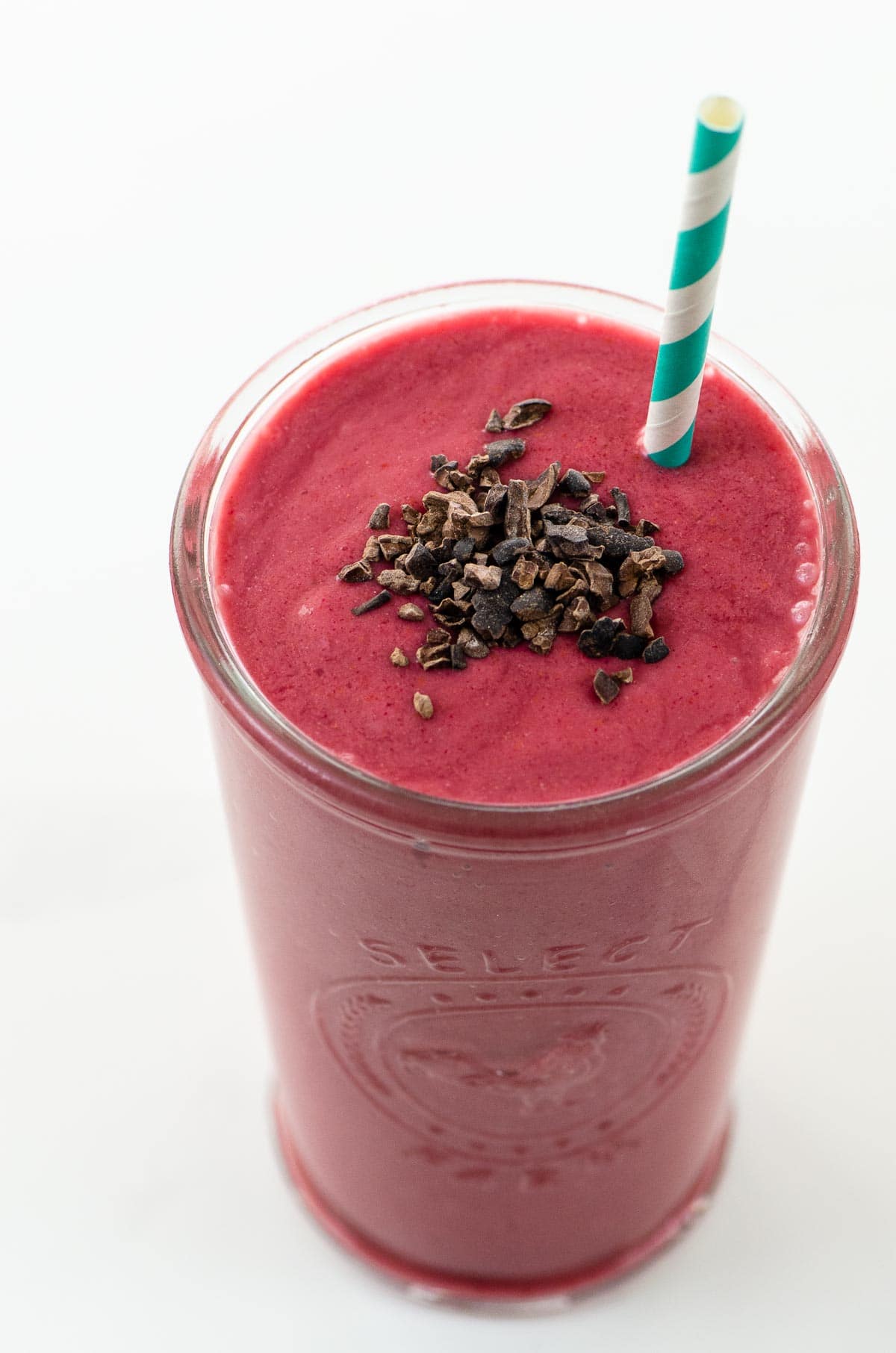
This is a guide to help you whiz up the most delicious possible smoothies in your blender, even without using recipes. We'll talk:
- Favorite ingredients
- All-important smoothie texture
- Add-ins for protein and sweetness
- Tips for getting the most out of your equipment
We'll discuss regular fruit-based and other sweet smoothies as well as savory smoothies, and I'll answer lots of questions about how to make those ubiquitous, sometimes hazardous-looking green smoothies work for you.
I first published this smoothie basics post as part of my regular juices and smoothies column on Serious Eats way back in 2013.
Flavor tips
Flavor is the first and most obvious component of smoothie basics. Here's how to think about building a smoothie with great flavors, even if you don't have a recipe to work with.
Fruit & other sweet smoothies
Let's start with some good news. If you can think of a baked dessert, an ice cream flavor, a milkshake, juice, or lemonade flavor, a coffee or tea drink, or any little sweet nothing that you like, you can make it into a smoothie. Or go simple and simply perfect with your smoothie basics, as in our raspberry banana smoothie below.
And you can make it into a reasonably or even very good-for-you smoothie with some thoughtful substitutions.
- Instead of creams, think yogurt, or cashews blended with water.
- Instead of sugar or caramel, think dates (and check the section on sweetening below).
- Instead of sweetened bar chocolate, try raw cacao powder.
You can add interest with spices like cinnamon, nutmeg, cloves, ginger, and allspice, just as you would in a baked recipe...but in much smaller quantities.
Great sweet smoothie ingredients
- Liquids: Water, dairy or non-dairy milks*, coffee, brewed teas and tisanes, kefir, coconut water, coconut milk with the fat skimmed (so it doesn't coagulate when cold), fresh juices that you've just made, lemonade
- Fruits: Berries, cherries, bananas, melons, mangoes, peaches, nectarines, apricots, cooked pumpkin and other winter squash
- Herbs and Spices: Vanilla, cinnamon, nutmeg, allspice, cloves, cardamom, anise, mint, basil, cilantro
*If you have a high-speed blender, a great substitute for nut milk is ¼ cup of raw nuts and 1 to 2 cups of water. If you have a regular blender, a tablespoon of nut butter per cup of water works too.
Flavor: Green smoothies
Love 'em or leave 'em, green smoothies are definitely a thing. And they're a thing that can taste pretty grotesque or actually really delicious, depending on how much you know. I'll address the critical question of texture a bit later; for now, let's tackle taste.
There are two approaches to green smoothies. One is to hide some greens in an otherwise sweet smoothie. Spinach works great here, since the taste is easily overridden with other flavors.
The other approach is to embrace the greenness and balance the flavors as you would with a juice. Choose a sweet or savory approach (for savory, skip the fruit and add a pinch of salt or even a splash of soy sauce, if you're into it). Then think of ingredients that would make a good salad or soup, and they'll probably taste pretty good together. Savory green smoothies are a great place to experiment with leafy herbs.
The color of our food and drinks affects how they taste to us. Smart ingredient combinations — ones that don't produce grey or brown drinks — go a long way toward making good smoothies. I once made a "green" smoothie that turned out essentially black. A word of advice based on that experience: No.
Great green smoothie ingredients
- Liquids: Water, green tea, coconut water, fresh juices that you've just made
- Fruits: Apples, pears, pineapples, light-colored melons, peaches, nectarines, grapes
- Greens: Cucumber, kale, spinach, lettuce, chard, arugula, mustard greens, beet greens, dandelion, sorrel
- Herbs: Basil, cilantro, mint, chervil, ginger, dill, chives, garlic, marjoram, parsley, thyme, tarragon
How to improve your smoothie texture
Smoothie basics are as much about texture as about flavor. A good fruit smoothie:
- Has a satisfying, creamy chill but isn't noticeably icy
- Maintains its texture and emulsification as it warms up a bit so you don't have to inhale it in the first eight seconds
- And if you let it, it should be able to trick you into thinking you're drinking a luscious dessert
A good green smoothie should be absolutely, perfectly smooth, with a bit of heft from higher-fat ingredients.
Here are my top tips for achieving that level of smoothie bliss.
Freeze!
Blending up some ice cubes with your ingredients is okay in a pinch but can make it hard to get a good consistency going, so if you can freeze some of your smoothie ingredients ahead of time, you should.
I'd estimate that the best consistency for a fruit smoothie usually comes from using two-thirds frozen ingredients where possible. Individual blender mileage will vary, so play around to see what works best.
For the most part, fruit is a freezing no-brainer. Peeled whole or sliced bananas, berries and cherries, sliced stone fruits, tropical fruits, grapes, and many other fruits freeze beautifully and still blend up well in a regular blender as long as you've cut them small and added enough liquid. High-speed blenders can handle large pieces of frozen fruit without much trouble as long as there's some liquid to get them started.
Depending on the strength of your blender, it can also be worth freezing a portion of the liquid ingredients. Nut milks, yogurt, coffee (with or without milk added), and even juices can be frozen in ice cube trays and added directly to the blender. Some of these may get a little icy, but but if there's a choice between adding frozen juice cubes and regular water-based ice cubes to a recipe, it's worth freezing the juice so as not to dilute the flavor.
Ingredients to add for better texture
Nut Butters: Nothing takes a sweet smoothie from creaminess zero to hero as easily as a tablespoon or two of peanut, almond, or other nut or seed butter of your choice.
Avocado is a second contender for most magical purveyor of creaminess to smoothies, and it's by far the best choice for green smoothies. You can even add half an avocado at the last minute to fix the texture of a smoothie that just isn't working out the way you'd hoped. It mellows flavors as well. Don't be afraid to try the avocado trick with fruit smoothies, too.
Cooked Oatmeal: In both sweet and savory smoothies, a few tablespoons of cooked oatmeal works wonders for adding creamy texture. I discovered this almost by accident, and it's one of the best tricks I know.
Greek Yogurt: In just about all smoothie types, a little Greek yogurt fills out texture beautifully.
Coconut Oil: In green smoothies where your ingredients aren't too cold, a tablespoon or two of virgin coconut oil adds good creaminess and a nice coconut flavor to the mix.
Sweeteners: The mighty Medjool date, the insanely ripe banana, and more
As far as I'm concerned, the queen of smoothie sweeteners is the Medjool date. It's super-sweet and caramel-like, and I've yet to find a smoothie in need of sweetness whose flavors were incompatible with the queen's.
If you're working with a high-speed blender, just remove the pit and drop in the whole date, no questions asked. Otherwise, it pays to know your blender.
- Some regular blenders can handle a chopped date just fine, but others will never get it completely smooth.
- If yours falls into the latter category, try soaking a finely chopped date in a little warm water or a bit of the liquid called for in the smoothie recipe, then blending it into a loose date paste before adding the rest of the smoothie ingredients.
Another great sweetening method for smoothies with bananas in them is simply to use really, really ripe bananas. This sounds sort of ridiculous but is actually an important part of my smoothie-making regime.
- Once every couple of months I'll buy a large quantity of bananas and let them ripen almost to oblivion, which is the perfect point of sweetness.
- Then I'll peel them and freeze them whole or halved in zip-top bags.
I don't typically sweeten smoothies outside of these methods, but if you want to, liquid sweeteners are your friends and will help you avoid a gritty texture. Try maple syrup if you think it will add a complementary flavor, honey, agave if you're into that, or even simple syrup. A spoonful of jam is brilliant, too.
Other smoothie add-ins
There's a wide array of purported superfood and other just plain delicious ingredients to add to your smoothies. Some of my favorites are:
- Ground flax seed
- Chia seeds
- Maca
- Raw cacao
- Matcha
Then, of course, there's protein powder. Protein powders are a tricky business, varying tremendously in terms of ingredient quality, taste, and texture. I stayed away from them for years but ultimately discovered a pea protein and a brown rice protein that meet my needs on all of those fronts on days when I want a little extra staying power in my smoothies.
If you find a product that meets your nutritional goals and doesn't have a discernible taste or chalky texture, protein powders can be added to most smoothies without too much tinkering. You may find you need a bit of extra liquid to absorb the powder and that it's better to drink those smoothies relatively quickly after blending.
A word on equipment: High-speed vs. regular blenders
One final critical element of smoothie basics is finding the right blender for your needs.
Like ovens, regular blenders vary widely and each have their own personality and abilities. Some blend dates and even greens pretty well, and some, like my old (fairly pricey) one, just make a chopped salad instead of a green smoothie and then look you in the eye like everything's fine.
Lots of folks seem to want to hop on the high-speed (Vitamix, Blendtec, etc.) bandwagon but aren't sure it's worth the hefty price. I've had one for a many years now with no regrets except that once it scared the bejeezus out of my two-year-old neighbor. I didn't see her out on the balcony again for several days.
I use my blender almost daily, at least as much for salad dressings, sauces, and soups as for smoothies. In my case green smoothies were a no-go with a regular blender. But even for fruit smoothies I think the high-speed gives a better result since it can handle a higher ratio of frozen fruit to liquid.
Whether or not to buy a high-speed blender is really a personal decision, dictated as much by your cooking patterns as by your smoothie-making ones. Rather than give generic advice, I'm happy to answer any specific questions on this topic (and most others) in the comments.
Happy blending, folks. Hope this smoothie basics post helps you find your own freestyle liquid groove.
More resources for juice & smoothie basics
- DIY Juice Cleanse (coming soon)
- Juicing for beginners
- Green Juice for beginners and experts alike
- Turmeric shots
- Green smoothie for beginners
- SmoothieBox review
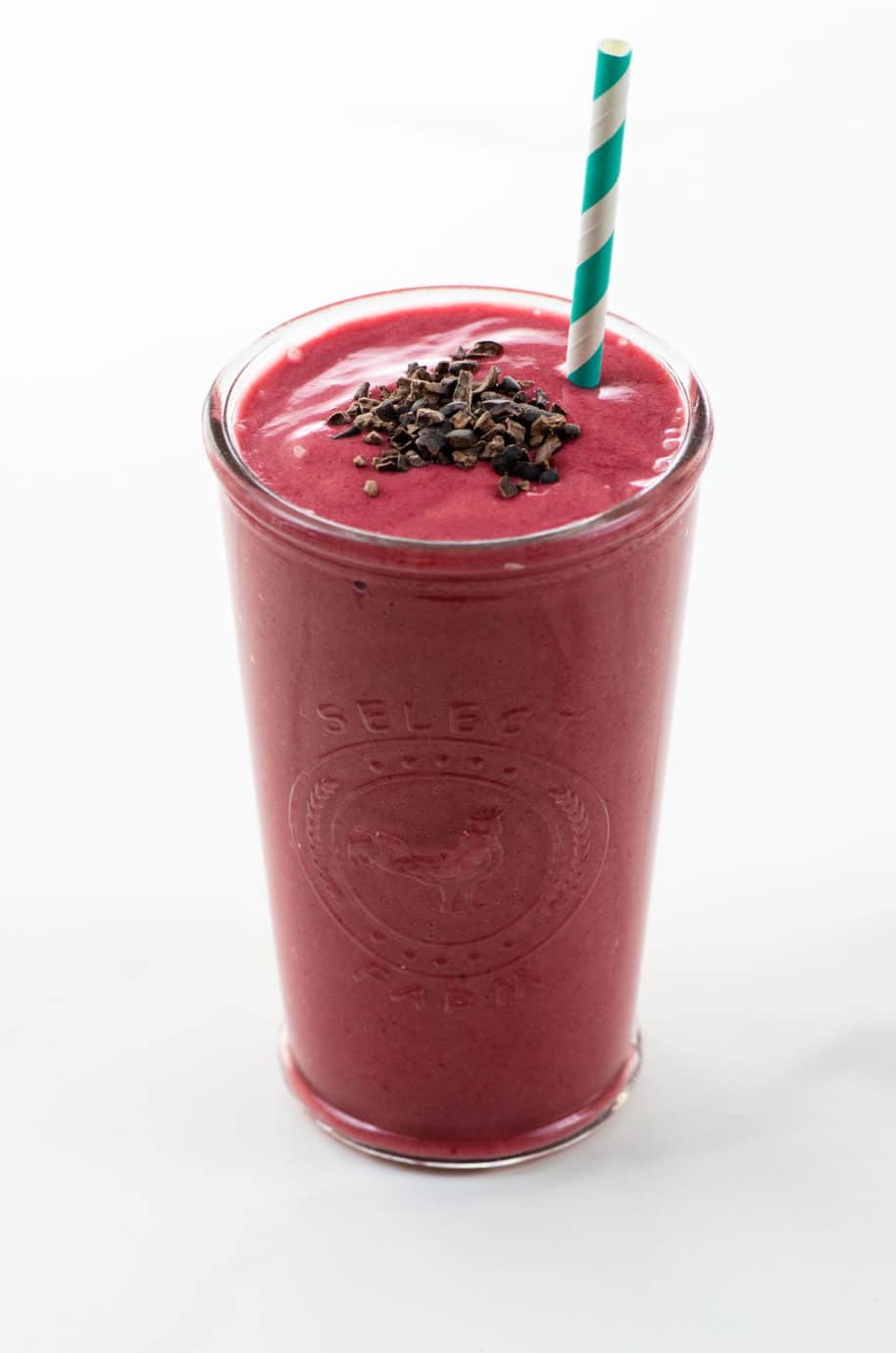
Hungry for more?
Subscribe to Umami Girl's email updates, and follow along on Instagram.
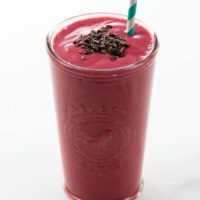
Raspberry Banana Smoothie
Ingredients
- 1 cup frozen raspberries
- 1 medium frozen banana
- 1 tablespoon peanut butter
- ⅔ cup cold water
- ½ teaspoon maca powder (optional)
- Cacao nibs (optional, to garnish)
Instructions
- Place all ingredients (except cacao nibs, if using) into a regular or high-speed blender and blend until perfectly smooth.
- Pour into a glass, garnish with cacao nibs if you like, and serve right away.
Notes
- If using a regular blender, slice the frozen banana before adding it. If using a high-speed blender, you can just break it into two or three large pieces.
- How thick or thin you like your smoothies is a highly personal decision. Feel free to add more or less water to suit your taste, as long as there's enough to satisfy your blender.
- Maca is a Peruvian root vegetable long considered to increase virility. These days it's used as a superfood since it's jam-packed with micronutrients that can be lacking in the standard diet. It has a subtle, almost malt-like flavor that I enjoy in smoothies. It's 100% optional in this recipe.
- Cacao nibs are also totally optional. They, too, are full of health-promoting micronutrients, and they add a subtle depth and earthiness to smoothies if you blend them in (and a nice crunch if you garnish with them). They're unsweetened and therefore quite bitter (like taking a bite of baking chocolate), so don't snack on them — but they work very well in combination with this and many other smoothies.
- If you have leftovers, you can pour them into ice cube trays, freeze, transfer the cubes to a zip-top bag, and then re-blend them with a little more water or add to other smoothies.
Nutrition
Hungry for more?
Subscribe to Umami Girl's email updates, and follow along on Instagram.


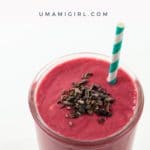
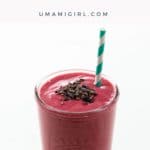
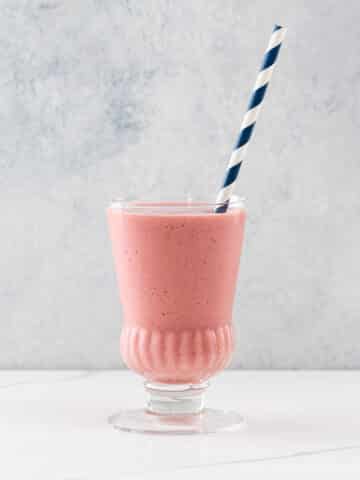
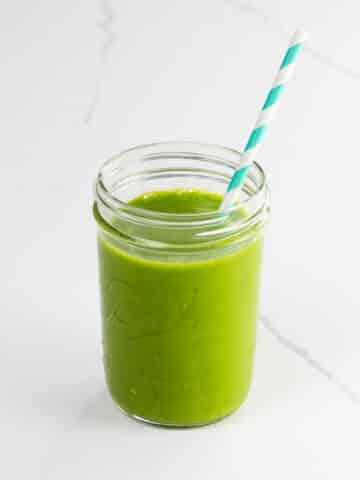
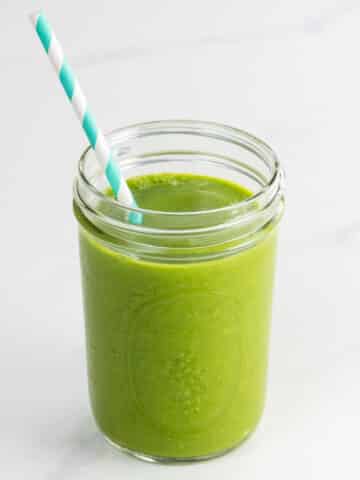
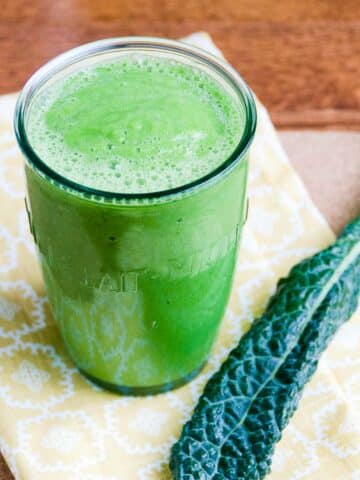

Leave a Reply